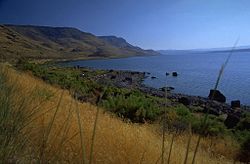Abert Lake
| Lake Abert | |
|---|---|

East shore of Lake Abert
|
|
| Location | Lake County, Oregon |
| Coordinates | 42°37′34″N 120°13′59″W / 42.626°N 120.233°WCoordinates: 42°37′34″N 120°13′59″W / 42.626°N 120.233°W |
| Type | Endorheic |
| Primary inflows | Chewaucan River |
| Catchment area | 820 square miles (2,100 km2) |
| Basin countries | United States |
| Max. length | 15 mi (24 km) |
| Max. width | 7 mi (11 km) |
| Surface area | 57 square miles (150 km2) |
| Max. depth | 11 ft (3.4 m) |
| Surface elevation | 4,259 ft (1,298 m) |
Lake Abert (also known as Abert Lake) is a large, shallow, alkali lake in Lake County, Oregon, United States. It is approximately 15 miles (24 km) long and 7 miles (11 km) wide at its widest point. It is located 3 miles (4.8 km) northwest of the small, unincorporated community of Valley Falls, Oregon. The lake was named in honor of Colonel John James Abert by explorer John C. Fremont during his 1843 expedition into Central Oregon. No fish live in the alkaline waters of the lake; however, its dense population of brine shrimp supports a variety of shorebirds. The lake is also an important stop on the bird migration route known as the Pacific flyway.
The arid land around Lake Abert was once lush. During the epoch, vast areas of south-central Oregon were covered by lakes and wetlands. As the last ice age was ending, rain and runoff from melting snow filled the lowlands throughout this region of the Great Basin, creating an immense freshwater lake called Lake Chewaucan. The lake covered 461 square miles (1,190 km2) at depths of up to 375 feet (114 m).
Lake Chewaucan covered the Abert and Summer Lake basins for most of the late Pleistocene epoch. The last high water period occurred about 13,000 years ago. There is no archaeological evidence of human utilization of Lake Chewaucan during this time. The earliest evidence for possible human occupation of the basin comes from the Paisley Caves were originally excavated by Luther Cressman in the late 1930s. Cressman found some inconclusive evidence that humans could have begun occupation of the area around 11,000 years ago. Further excavations of the site by Dennis Jenkins since 2002 have yielded evidence of occupation of the area as far back as 14,300 years ago.
...
Wikipedia
